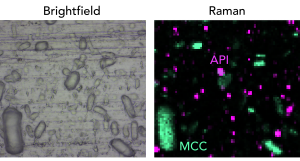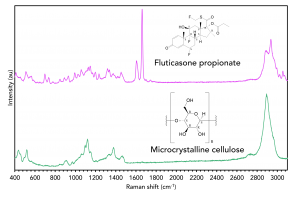Map of the Month – Hay Fever Medication
Key Points
• Hay fever and cold relief nasal sprays work by directly combatting ongoing symptoms.
• The active pharmaceutical ingredient in medicinal nasal spray is a steroid, which works by reducing inflammation.
• Raman imaging can be used to map the distribution of different components within nasal spray formulations, including the active pharmaceutical ingredient.
Welcome to Edinburgh Instruments’ blog celebrating our work in Raman, Photoluminescence, and Fluorescence Lifetime Imaging. Every month we aim to highlight our pick for Map of the Month to show how our Raman and fluorescence spectrometers can be used to reveal all the hidden secrets in your samples.
August
Last month, we discussed the cause of hay fever: microscopic pesky pollen particles that trick our bodies into having an immune response. Fortunately, our summers don’t have to be all doom and gloom. This time around we are looking at hay fever nasal sprays, one of the main treatments for the allergy. Unlike antihistamine medications, which are primarily taken for the prevention of symptoms, nasal sprays are designed to provide relief of ongoing symptoms.
Why do nasal sprays work?
The answer lies in the chemistry of the active pharmaceutical ingredient (API). The API in hay fever nasal sprays is always a steroid, a class of drug that is great at lessening the effects of the body’s immune response (sneezing, runny nose, congestion) because it acts by reducing inflammation. We looked at a nasal spray containing the API fluticasone propionate with the RM5 Confocal Raman Microscope and performed a Raman image to see the distribution of the steroid throughout the spray. As is shown in the brightfield microscope image above, there are various microparticles distributed all throughout the spray, but what are they?
When the same area is imaged using Raman spectroscopy, the particles can be identified as the API (pink), or other ingredients in the formulation such as microcrystalline cellulose (MCC, green), which acts as a physical barrier against airborne pollen and other irritants. The spectra for these ingredients, which were matched to the steroid and cellulose chemical structures using KnowItAll software, are shown below.










